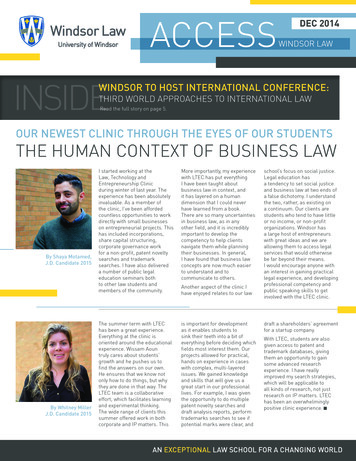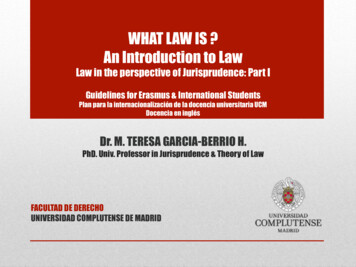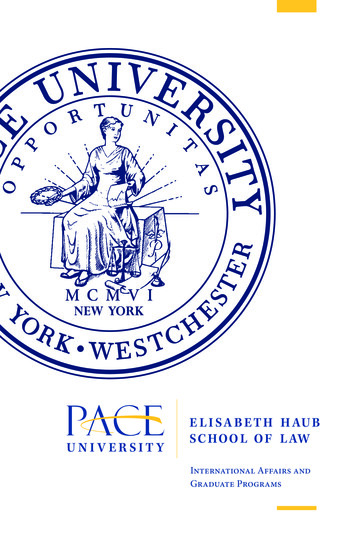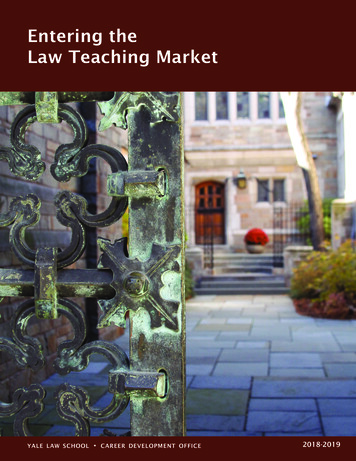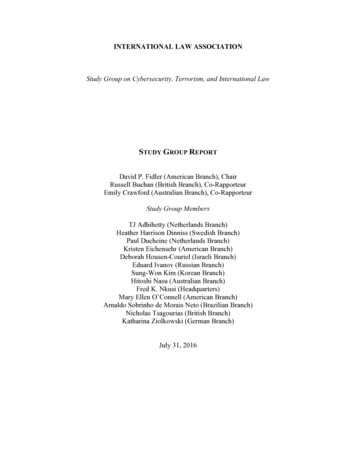
Transcription
INTERNATIONAL LAW ASSOCIATIONStudy Group on Cybersecurity, Terrorism, and International LawSTUDY GROUP REPORTDavid P. Fidler (American Branch), ChairRussell Buchan (British Branch), Co-RapporteurEmily Crawford (Australian Branch), Co-RapporteurStudy Group MembersTJ Adhihetty (Netherlands Branch)Heather Harrison Dinniss (Swedish Branch)Paul Ducheine (Netherlands Branch)Kristen Eichensehr (American Branch)Deborah Housen-Couriel (Israeli Branch)Eduard Ivanov (Russian Branch)Sung-Won Kim (Korean Branch)Hitoshi Nasu (Australian Branch)Fred K. Nkusi (Headquarters)Mary Ellen O’Connell (American Branch)Arnaldo Sobrinho de Morais Neto (Brazilian Branch)Nicholas Tsagourias (British Branch)Katharina Ziolkowski (German Branch)July 31, 2016
INTERNATIONAL LAW ASSOCIATIONStudy Group on Cybersecurity, Terrorism, and International LawSTUDY GROUP REPORTCONTENTSTable of Contents . iiChair’s and Co-Rapporteurs’ Note . viAbbreviations . viiExecutive Summary . viii1. INTRODUCTION .11.1 The Study Group’s Objectives.11.2 The Report’s Analytical Framework .31.2.1 Terrorism and International Law .31.2.2 Cyber Terrorism and International Law .51.3 Options for International Legal Action .62. PRELIMINARY CONSIDERATIONS .72.1 Cyberspace and Terrorism .72.1.1 Scope of the Study Group’s Analysis .72.1.2 Terminology in Analyzing Cyber Terrorism .92.2 Internet Governance and Cyber Terrorism .92.3 Technology and Cyber Terrorism .102.4 International Law and Cyber Terrorism .122.5 State-Sponsored Terrorism, Weak States, and Cyber Terrorism .152.5.1 State-Sponsored Terrorism and Cyber Terrorism .152.5.2 Weak States and Cyber Terrorism .173. DEFINING “CYBER TERRORISM” .183.1 Defining “Terrorism” and International Law .183.2 Considerations in Defining Cyber Terrorism .213.2.1 Acts.213.2.2 Damage .223.2.3 Specific Intent.243.2.4 Actors .253.3 The Study Group’s Working Definition of Cyber Terrorism .25ILA Study Group Report on International Law & Cyber Terrorismii
4. INTERNATIONAL LAW AND RESPONDING TO CYBER TERRORISM .284.1 Responding to Terrorism and International Law .284.2 Anti-Terrorism Treaties .284.2.1 Cyber Terrorism and Offenses Created by Anti-Terrorism Treaties .284.2.2 The Terrorism Bombings Convention, Terrorist Financing Convention,and Nuclear Terrorism Convention .304.2.3 Multilateral Anti-Terrorism Treaties Not in Force .324.2.4 Regional Anti-Terrorism Treaties .344.2.5 Draft Comprehensive Convention on International Terrorism .354.2.6 Potential Steps Concerning the Anti-Terrorism Treaties and CyberTerrorism .364.3 Beyond the Anti-Terrorism Treaties .364.3.1 Security Council Counter-Terrorism Mandates .374.3.2 Customary International Law and the Crime of Terrorism .384.4 Treaties on Cyber Crime, Transnational Organized Crime, Extradition,and Mutual Legal Assistance and Extraterritorial Application of CriminalLaw .394.4.1 Cyber Crime Treaties and Cyber Terrorism.394.4.2 Transnational Organized Crime and Cyber Terrorism .404.4.3 Extradition and Mutual Legal Assistance Treaties and CyberTerrorism .414.4.4 Extraterritorial Jurisdiction, International Law, and CyberTerrorism .424.4.5 Summary on Cyber Crime, Transnational Organized Crime, Extradition,and Mutual Legal Assistance Treaties and Extraterritorial Application ofCriminal Law .434.5 The Use of Force in Self-Defense, Sanctions, and Responding to CyberTerrorism .434.5.1 The Use of Force in Self-Defense and Responding to Terrorism .434.5.2 Cyber Terrorism and the Use of Force in Self-Defense .454.5.3 Sanctions and Cyber Terrorism .484.6 International Humanitarian Law and Responding to Cyber Terrorismduring Armed Conflict .494.6.1 The Prohibition on Acts or Threats of Violence Committed with thePrimary Purpose of Terrorizing Civilians .494.6.2 International Criminal Law and Violation of the Prohibition on Acts orThreats of Violence Intended to Spread Terror Among Civilians .504.6.3 Prohibitions on Measures or Acts of Terrorism .514.7 Response Assistance, International Law, and Cyber Terrorism.54ILA Study Group Report on International Law & Cyber Terrorismiii
4.8 International Law and Responding to Cyber Terrorism: Summary ofOptions for International Legal Action .564.8.1 Better Utilization of Existing International Law .564.8.2 Creating New International Law .575. INTERNATIONAL LAW AND PROTECTING AGAINST CYBER TERRORISM.605.1 Protecting against Terrorism and Cyber Terrorism through an “AllHazards” Approach .605.2 Critical Infrastructure Protection, International Law, and CyberTerrorism .635.2.1 Existing International Legal Mechanisms and Critical InfrastructureProtection.635.2.2 Treaty Law Specific to Critical Infrastructure Protection.665.2.3 New Norms Supporting Critical Infrastructure Protection .675.2.4 Controversy over Revising the International TelecommunicationRegulations .685.2.5 Critical Infrastructure Protection, International Law, and the PrivateSector .695.2.6 Critical Infrastructure Protection and International Law:Summary .695.3 Resilience, International Law, and Cyber Terrorism .705.4 Beyond Critical Infrastructure: Due Diligence, International Law, andProtecting against Cyber Terrorism .705.5 Securing Dangerous Materials, International Law, and CyberTerrorism .715.6 Export Controls and Protecting against Cyber Terrorism .725.7 Situational Awareness, Civil and Political Rights, and ProtectionStrategies.745.8 International Law and Protecting against Cyber Terrorism: Summary ofOptions for International Legal Action .755.8.1 Better Utilization of Existing International Law .755.8.2 Creating New International Law .766. INTERNATIONAL LAW AND PREVENTING CYBER TERRORISM .776.1 Preventing Terrorism and International Law .776.2 Defining Terrorism and Preventing Terrorism .786.3 Security Council Mandates on Terrorism Prevention and CyberTerrorism .796.4 Terrorism Prevention in Treaty Law and Preventing CyberTerrorism .80ILA Study Group Report on International Law & Cyber Terrorismiv
6.5 Surveillance, International Human Rights, and Preventing CyberTerrorism .826.5.1 Preventing Terrorism, Surveillance, and International Human RightsLaw.826.5.2 Preventing Cyber Terrorism, Surveillance, and International HumanRights Law .846.5.3 Preventing Cyber Terrorism, Encryption, and International Law .846.6 Use of Military Force, International Law, and Preventing CyberTerrorism .856.7 Root Causes of Terrorism, International Law, and Preventing CyberTerrorism .876.8 International Law and Preventing Cyber Terrorism: Summary ofOptions for International Legal Action .876.8.1 Better Utilization of Existing International Law .876.8.2 Creating New International Law .887. CONCLUSIONS .907.1 The Report and the Study Group’s Objectives .907.1.1 Examine the Potential Threat of Cyber Terrorism .907.1.2 Develop a Definition of Cyber Terrorism .917.1.3 Identify and Analyze International Law Potentially Relevant toCyber Terrorism .917.2 Assessment of Potential Actions to Strengthen International LawApplicable to Cyber Terrorism .917.2.1 Better Utilization of Existing International Law .927.2.2 Creating New International Law .927.3 Recommendations for the International Law Association .93ANNEX: DEFINITIONS OF “CYBER TERRORISM” .94BIBLIOGRAPHY .98ILA Study Group Report on International Law & Cyber Terrorismv
Chair’s and Co-Rapporteurs’ NoteThe chair and the co-rapporteurs would like to thank the members of the Study Group fortheir willingness to participate in this project and for the comments they provided to us asthe project developed and moved to completion. The complexity of the Study Group’stopic, the challenging nature of our objectives, and the extensive range of internationallegal issues the report covered made this project difficult to organize and execute. Thepatience and expertise of Study Group members helped the process move forwardeffectively and efficiently. We hope the final report does justice to the time and attentionthe members of the Study Group devoted to this project.David P. Fidler, Chair (American Branch)Russell Buchan, Co-Rapporteur (British Branch)Emily Crawford, Co-Rapporteur (Australian Branch)ILA Study Group Report on International Law & Cyber Terrorismvi
AbbreviationsASEANAssociation of South East Asian NationsAUAfrican UnionCENTCOMCentral CommandCIPCritical infrastructure protectionCOECouncil of EuropeEUEuropean UnionGFCEGlobal Forum for Cyber ExpertiseGGEIAEAUN Group of Governmental Experts on Developments in the Field of Informationand Telecommunications in the Context of International SecurityInternational Atomic Energy AgencyICAOInternational Civil Aviation OrganizationICCInternational Criminal CourtICRCInternational Committee of the Red CrossICTRInternational Criminal Tribunal for RwandaICTsInformation and communication technologiesICTYInternational Criminal Tribunal for the Former YugoslaviaIHLInternational humanitarian lawIHRInternational Health RegulationsILAInternational Law AssociationIMOInternational Maritime OrganizationITRInternational Telecommunication RegulationsITUInternational Telecommunication UnionMLATMutual legal assistance treatyNSANational Security AgencyNATONorth Atlantic Treaty OrganizationOASOrganization of American StatesOECDOrganization for Economic Cooperation and DevelopmentSCSLSpecial Court for Sierra LeoneUNUnited NationsWHOWorld Health OrganizationWMDWeapons of mass destructionILA Study Group Report on International Law & Cyber Terrorismvii
Executive SummaryIntroductionThe International Law Association (ILA) established the Study Group on Cybersecurity,Terrorism, and International Law at the end of 2013 to examine international law relatedto cyber terrorism. The chair and co-rapporteurs invited experts and scholars from ILAbranches around the world to participate in the Study Group, and ILA members fromeleven countries joined the Study Group. During 2014, the members of the Study Groupprovided input on the objectives of the project, the structure of the research agenda, andthe international legal issues the project needed to address. The chair and co-rapporteursprepared two full drafts of the report (May 2015, December 2015) and invited StudyGroup members to comment on the drafts. This report constitutes the Study Group’s finaldraft submitted to the ILA.The Study Group identified four main objectives for its work: Examine the potential threat posed by cyber terrorism, including howtechnological trends and innovations might affect the threat;Develop a definition of “cyber terrorism” to guide its analysis based oninternational law and state practice;Produce and analyze an inventory of international law potentially relevant tocyber terrorism; andAssess whether pro-active international legal actions concerning potential actsof cyber terrorism would be worthwhile and feasible.Examine the potential threat posed by cyber terrorismThe Study Group reviewed primary documents and secondary literature on the threat ofcyber terrorism (see Chapters 1-2). It noted the continued gap between concernsexpressed by policymakers and experts about cyber terrorism and the lack of cyberincidents widely acknowledged to involve acts of terrorism. Analyses of technologicaltrends and innovations often identify the potential for such changes to facilitate acts ofcyber terrorism. Such technological developments, along with threats posed by terroristgroups, such as Al Qaeda and the so-called “Islamic State,” ensure that concerns aboutcyber terrorism have not dissipated, despite the lack of cyber terrorism incidents. Thepolitical prominence of these concerns made the Study Group’s focus on internationallaw relevant to the policy landscape developing on this issue.Develop a definition of “cyber terrorism”The Study Group noted the lack of an agreed definition of “cyber terrorism” in policy,law, and scholarly literature. It reviewed existing international law on terrorism in orderto identify what elements a definition of cyber terrorism should include (see Chapter 3).On the basis of this research, the Study Group developed a working definition of cyberterrorism to guide its work:ILA Study Group Report on International Law & Cyber Terrorismviii
“Cyber terrorism” involves acts intentionally committed by any person who usesinformation and communication technologies unlawfully in ways that cause, or areintended to cause, death or serious bodily injury to persons, substantial damage topublic or private property, the economy, or the environment, or serious disruption ofpublic services and that are undertaken with the intent to spread fear in civilianpopulations or to compel a government, a civilian population, or an internationalorganization to take or abstain from specific acts or courses of action.Produce an inventory of international law potentially relevant to cyber terrorismIn combatting terrorism, states and international organizations have formulated policiesto achieve three strategic objectives: respond to acts of terrorism, protect againstterrorism, and prevent terrorist attacks. The Study Group used this “respond, protect, andprevent” framework to organize its analysis of international law relevant to cyberterrorism. Applying this approach, the Study Group analyzed an extensive amount ofinternational law. The bulk of the Study Group’s report—Chapters 4, 5, and 6—examinesthe international law implicated by the threat of cyber terrorism.The Study Group’s analysis of responding to cyber terrorism (see Chapter 4) includedexamining multilateral and regional anti-terrorism treaties, the draft ComprehensiveConvention on International Terrorism, Security Council resolutions on terrorism, thepurported crime of international terrorism in customary international law, treaties oncyber crime and transnational organized crime, extradition and mutual legal assistancetreaties, international law on the use of force, international humanitarian law, andinternational criminal law.In assessing international law relevant to protecting against cyber terrorism (seeChapter 5), the Study Group concentrated on international law connected to criticalinfrastructure sectors, such as nuclear energy and aviation. This law includes treaties thatestablish and guide international organizations working on critical infrastructure issues(e.g., International Atomic Energy Agency), as well as treaty law that specificallyaddresses protection of critical infrastructure from cyber threats. The Study Group alsoconsidered areas of international law relevant to: creating resilience in societies againstmalicious cyber activities (e.g., approaches used in transboundary pollution treaties),securing dangerous materials from terrorists, and using export controls as a counterterrorism strategy. Finally, international human rights law was analyzed because of theimportance electronic surveillance and information sharing have in protecting againstterrorism and cyber terrorism.In terms of preventing cyber terrorism (see Chapter 6), the Study Group focused onSecurity Council resolutions that impose binding obligations on terrorism prevention,treaties specifically on preventing terrorism, international human rights law andelectronic surveillance (including controversies over encryption), and international lawon the use of force in connection with anticipatory and pre-emptive self-defense.ILA Study Group Report on International Law & Cyber Terrorismix
Assess whether pro-active international legal actions concerning potential acts of cyberterrorism would be worthwhile and feasibleFrom its analysis of international law relevant to responding to, protecting against, andpreventing cyber terrorism, the Study Group identified options to improve thecontributions international law could make against the threat of cyber terrorism. Theoptions fell into two categories: (1) ideas for better utilization of existing treaty andcustomary international law; and (2) proposals for the development of new internationallaw. The following table summarizes the Study Group’s analysis:StrategicObjectiveOptions Analyzed Respond(Chapter 4,Section 4.8) Protect(Chapter 5,Section 5.8) Prevent(Chapter 6,Section 6.8) Better Use of Existing International LawWhere possible, ensure treaties on anti-terrorism, cyber crime,organized crime, extradition, and mutual legal assistance apply to cyberterrorismMake clear Security Council resolutions on terrorism apply to cyberterrorismCreating New International LawAmend, or adopt protocols to, relevant anti-terrorism, cyber crime, andorganized crime treaties to cover cyber terrorism expresslyAdoption of a Security Council resolution on cyber terrorismNegotiate a treaty on cyber terrorismBetter Use of Existing International LawIncrease attention on cyber defenses in existing treaty regimes thataddress critical infrastructure sectorsCreating New International LawInclude strengthening cyber defenses in a treaty on cyber terrorismBetter Use of Existing International LawMake clear existing Security Council resolutions on terrorism covercyber terrorismMake clear existing treaty law on terrorism prevention applies to cyberterrorismCreating New International LawSecurity Council adoption of a resolution on prevention of cyberterrorismInclude prevention of cyber terrorism in a treaty on cyber terrorismThe Study Group also identified where existing controversies in international lawcontinue when cyber terrorism is the focus. Long-standing debates about internationallaw on the use of force, including the rules on using force in self-defense, do not dissipatewhen cyber terrorism is the topic. Similarly, friction between political desires forexpanded counter-terrorism surveillance and the obligations to protect individual rights ininternational human rights law persists in the context of cyber terrorism.Finally (see Chapter 7), the Study Group made recommendations to the ILAconcerning (1) follow-on work advancing ideas discussed by the Study Group, such aspreparing a draft treaty specifically addressing cyber terrorism for states, internationalILA Study Group Report on International Law & Cyber Terrorismx
organizations, and non-governmental experts to consider; and (2) additional researchfocused on other aspects of the relationship between cyberspace and terrorism, such asthe international legal issues that arise from how terrorist groups use the Internet tocommunicate, spread propaganda, recruit and radicalize individuals, and raise funds.***ILA Study Group Report on International Law & Cyber Terrorismxi
1INTRODUCTION1.1 The Study Group’s Objectives1. The International Law Association (ILA) established the Study Group onCybersecurity, Terrorism, and International Law to examine international law related tocyber terrorism.1 Policy documents have frequently identified cyber terrorism as a threat,2even though experts do not believe terrorists have, to date, successfully conducted cyberattacks that qualify as terrorism, as opposed to terrorist groups using information andcommunication technologies (ICTs) and the Internet for other purposes.32. Even so, governments and experts fear terrorists will eventually use ICTs and theInternet to attack targets, such as cyber-enabled critical infrastructure, in order to terrorizesocieties by damaging economies and public services or causing injury or death.4 Cyberattacks by terrorists have the potential to be equally or more devastating than traditionalforms of kinetic terrorism. The present gap between often-voiced fears about cyberterrorism and the perceived lack of it has contributed to analyses of cyber terrorismremaining general, speculative, and sporadic.53. International lawyers have studied and discussed cyber terrorism.6 For example, astudy sponsored by the Council of Europe in 2007 analyzed the applicability of existing1ILA, Study Group on Cybersecurity, Terrorism, and International Law, /1050.2See, e.g., White House, National Strategy to Secure Cyberspace (Feb. 2003), In its research, the Study Group did not identify any cyber incident that experts agree constitutesterrorism, as terrorism has traditionally been understood in policy and law. The lack of acknowledged actsof cyber terrorism flows, in part, from controversies about the definition of “cyber terrorism.” Chapter 3(Defining “Cyber Terrorism”) infra addresses definitional issues.4Report of the Group of Governmental Experts on Developments in the Field of Information andTelecommunications in the Context of International Security, UN Doc. A/68/98*, June 24, 2013[hereinafter GGE Report (2013)], ¶ 7 (observing that, if terrorists “acquire attack tools, they could carry outdisruptive ICT activities”); Report of the Group of Governmental Experts on Developments in the Field ofInformation and Telecommunications in the Context of International Security, UN Doc. A/70/174, July 22,2015 [hereinafter GGE Report (2015)], ¶ 6 (stating that “[t]he use of ICTs for . . . terrorist attacks againstICTs or ICT-dependent infrastructure, is an increasing possibility”).5For an extended treatment, see Cyberterrorism: Understanding, Assessment, and Response (Thomas M.Chen, Lee Jarvis, and Stuart MacDonald, eds.) (New York: Springer, 2014).6See, e.g., Kelly A. Gable, “Cyber-Apocalypse Now: Securing the Internet against Cyberterrorism andUsing Universal Jurisdiction as a Deterrent,” Vanderbilt Journal of Transnational Law (2010); 43: 57-118;Aviv Cohen, “Cybterterrorism: Are We Legally Ready?” Journal of International Business & Law (2010);9(1): 1-40; Yaroslav Shiryaev, “Cyberterrorism in the Context of Contemporary International Law,” SanDiego International Law Journal (2012); 14: 139-92; Eduard Ivanov, “Combating Cyberterrorism underInternational Law,” Baltic Yearbook of International Law (2014): 14: 55-69; Ben Saul and Kathleen Heath,“Cyber Terrorism,” in Research Handbook on International Law and Cyberspace (Nicholas Tsagourias andILA Study Group Report on International Law & Cyber Terrorism1
treaties on terrorism and cyber crime to cyber terrorism.7 Although helpful, existinginternational legal literature reflects neither sustained attention nor consensus on how todefine and analyze cyber terrorism.8 Continued warnings about cyber terrorism and thedamage it might cause invite more systematic international legal scrutiny of this potentialnational and international security threat. The increased interest in other aspects ofcybersecurity, such as how cyber weapons might affect international law on the use offorce and armed conflict,9 highlight the opportunity to study cyber terrorism more closelyunder international law.4. Conceived and initiated by Russell Buchan and Emily Crawford (co-rapporteurs),chaired by David Fidler, and advised by a global group of scholars and experts, the StudyGroup explored international law associated with potential terrorist use of cyber attacks.Generally, for the Study Group, a terrorist cyber attack involves non-state actors usingICTs to injure or kill persons, damage property, or seriously disrupt public services inorder to spread fear among civilians or compel populations or governmental authorities totake or abstain from specific actions.105. The Study Group excluded from its efforts terrorist use of ICTs and the Internet forother purposes, including communications, propaganda, recruitment, and fundraising.Nor did the Study Group examine how governments conduct counter-terrorism generallyin cyberspace, such as engaging in surveillance of electronic communications. Thesetopics are important, but t
The International Law Association (ILA) established the Study Group on Cybersecurity, Terrorism, and International Law at the end of 2013 to examine international law related to cyber terrorism. The chair and co-rapporteurs invited experts and scholars from ILA branches around the world to participate in the Study Group, and ILA members from

